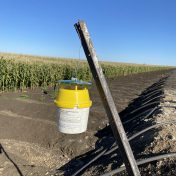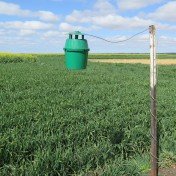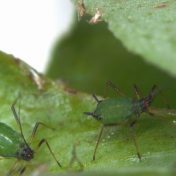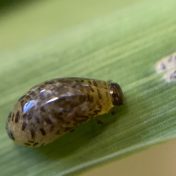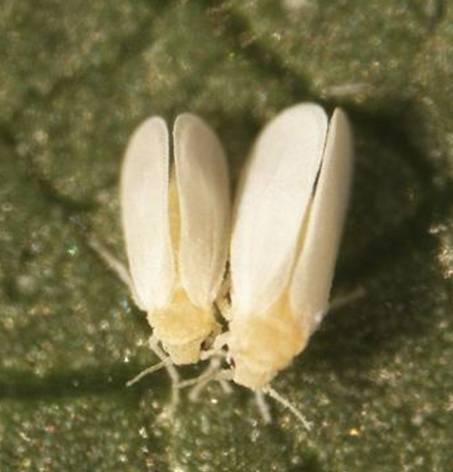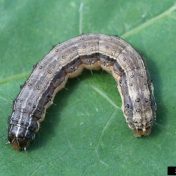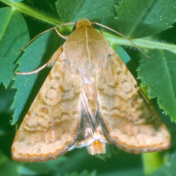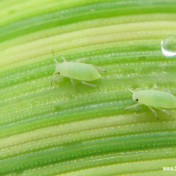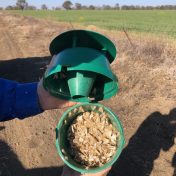Fall armyworm (FAW, Spodoptera frugiperda) is an exotic pest that was first detected on the Australian mainland in February 2020. State and federal biosecurity organisations have determined it to be unfeasible to eradicate this pest and it is now classified as endemic. In response to this incursion, the Queensland Government has funded a network of traps to better understand the… Read more »
The annual Helicoverpa spp. pheromone trapping program for the Northern Grains Region commenced last month. During the first few weeks of trap catches, trap operators have detected flights of both H. punctigera and H. armigera in pheromone traps across the Northern Region. As we have seen in the last six years of our trapping program, H. armigera flights are consistently… Read more »
Faba bean aphid (FBA, Megoura crassicauda) was first noted in Australia on broad beans (Vicia faba L. cv. Coles Early Dwarf) in October 2016 in a Sydney suburb, (Hales et al., 2017). FBA was then recorded in September 2017 at two faba bean trial sites: NSW DPI Tamworth Agricultural Institute (TAI) and Liverpool Plains Field Station Breeza (LPFS Breeza). These… Read more »
Each year NSW Department of Primary Industries conducts a Helicoverpa insecticide resistance surveillance program in the major summer cropping regions of NSW and QLD, focussed on detecting Helicoverpa resistance to the insecticides indoxacarb, emamectin benzoate and chlorantraniliprole. The program provides growers and advisors with an early warning system for potential resistance hot-spots in the northern region, and is essential for… Read more »
Over the past week, the Queensland Department of Agriculture and Fisheries (DAF) has received a number of enquiries about leaf damage in millet crops. The culprit is a native beetle (Oulema spp.), a member of the chrysomelid (leaf beetles) family. The larvae of the beetle are doing the leaf feeding. They are small, slimy-looking grubs with a hunched appearance. Fun… Read more »
The first major outbreak of silverleaf whitefly (SLW) in Australia occurred in 2001-02 in central Queensland. Although it hasn’t occurred again in such biblical proportions, SLW has spread across Australia and is still a pest to watch in many cotton crops, as the honeydew it secretes contaminates the lint. The original SLW threshold matrix developed in central Queensland recommended looking… Read more »
Fall armyworm (FAW, Spodoptera frugiperda) is an exotic pest that was detected in northern Queensland in a maize crop in February 2020. State and federal biosecurity organisations have determined it to be unfeasible to eradicate this pest and it is now classified as an endemic pest. Originating from tropical and sub-tropical areas of the Americas, FAW was reported in Africa… Read more »
Every year the Queensland Department of Agriculture and Fisheries runs a Helicoverpa spp. pheromone trapping program for the Northern Grains Region to detect flights of Helicoverpa armigera and Helicoverpa punctigera in important cropping areas. The trap network provides growers and agronomists with a warning system for potential egg-lay in susceptible crops. Although very few crops were planted this season due… Read more »
Are Russian wheat aphids (RWA) still moving north? No detections of RWA in crops have been received this year, and no detections from outside the already known distribution area. The most northerly detections to date (2018) were from Coonamble and Coonabarabran. We expect RWA to move further north every year and knowing where they are will help you prepare. Now… Read more »
The yearly Helicoverpa spp. pheromone trapping program for the Northern Grains Region, run by the Queensland Department of Agriculture and Fisheries (DAF), has recently commenced. During the first few weeks of trap catches, trap operators have detected flights of both H. punctigera and H. armigera in pheromone traps across the Northern Region (Table 1). Table 1. Latest Helicoverpa spp. pheromone… Read more »
